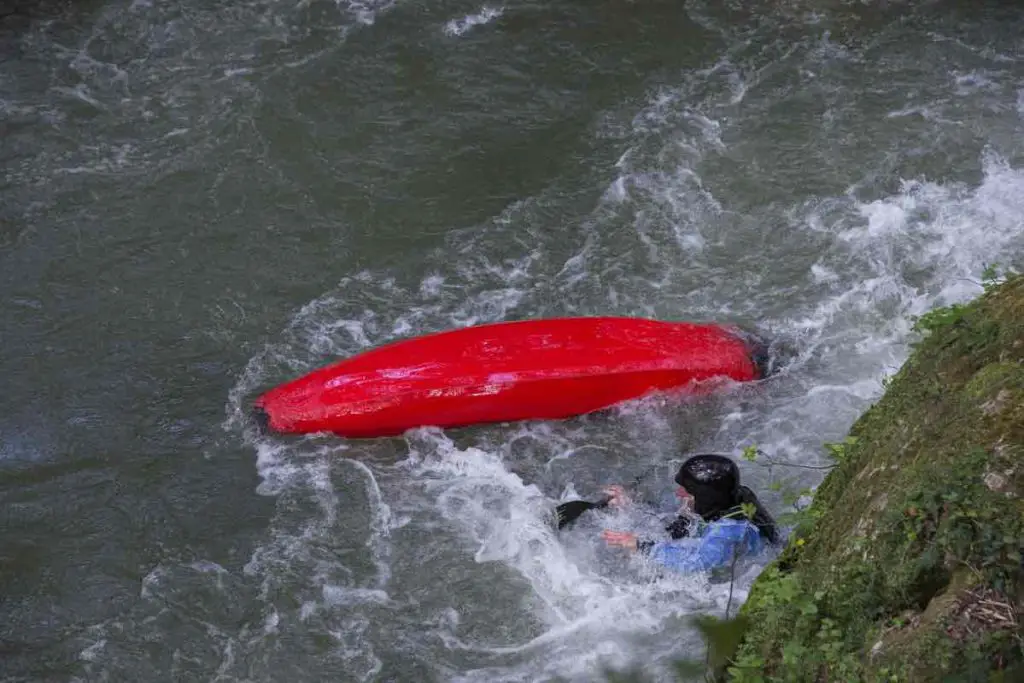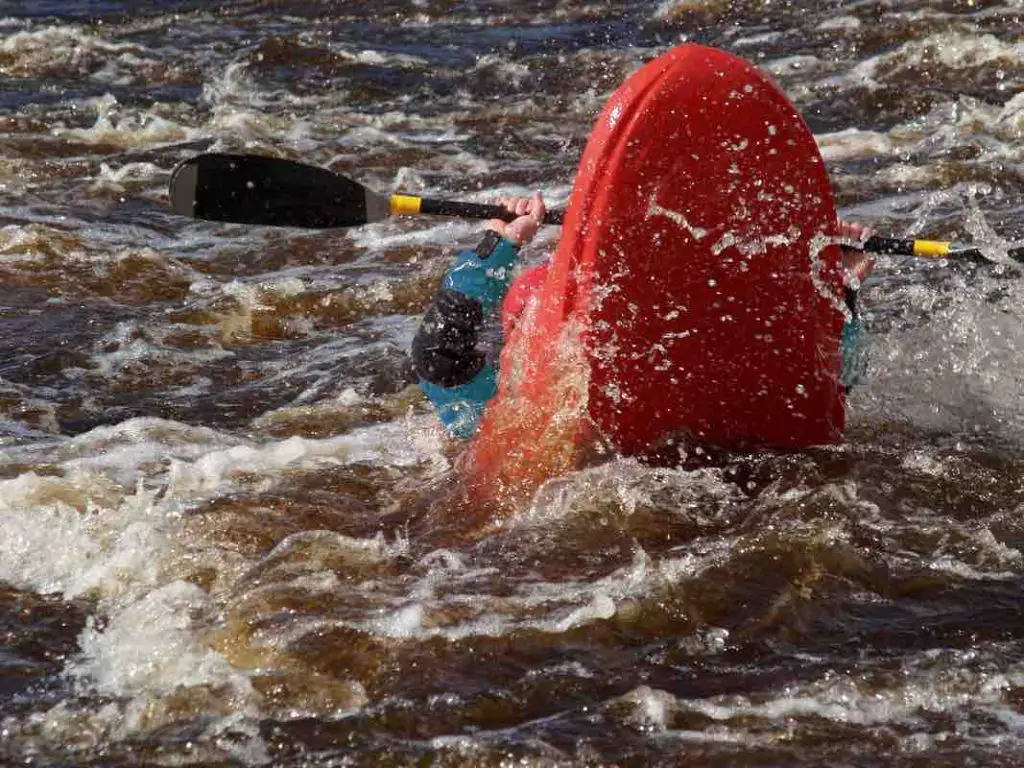Kayaking can be a blast for people of all ages, including those who haven’t spent much time on the water before. That said, paddling down a rough river can be intimidating, especially in these narrow boats. One common worry is getting stuck inside if the kayak turns over.
You can get stuck in kayaks if they flip over. However, the high water pressure and debris of white water mean that white water kayakers are more likely to get stuck than people kayaking in flat water. All kinds of kayakers should learn how to self-rescue, just in case.
This article will identify which kayaks you are more likely to get stuck in. Then I’ll give you a crash course in self-rescuing so that even if you are stuck underwater in a kayak, you won’t have to panic.

What Kind of Kayaks Can I Get Stuck In?
Although you can get stuck in any kayak, as I stated above, white water kayakers are far more likely to get stuck than flat water kayakers. But what is the difference between white water and flat water anyway?
White Water vs. Flat Water
Before worrying about getting stuck in a kayak, you need to decide where you want to go kayaking. The main difference between white and flat water kayaking is the difficulty.
White water refers to the color of frothy water. You’ll find white water in rushing rivers, large lakes, or rough conditions. So as you can guess, white water is slightly more difficult to kayak in.
Flat water refers to calmer, slower-moving water. Ponds and small- to medium-sized lakes usually only offer flat water kayaking. Unless weather causes the water to become rough, flat water kayaks will be easier for all ages.
Why You’re More Likely To Get Stuck in White Water Kayaks
If you’re afraid of getting stuck underwater, then you can rest assured this isn’t something you have to worry about in most flat water kayaks. White water kayaking takes place in rougher water, making dangerous situations more likely.
There are a few reasons you’re more likely to get stuck inside white water kayaks:
More Pressure From Water
Kayaks are designed so that you will naturally fall out if the boat flips over due to gravity. In flat water, the water surrounding you won’t offer any resistance.
Kayaking in white water means that if you fall out, the water pressure of the quickly moving water will keep you stuck in the kayak unless you take action.
White Water Is Disorienting
Experienced kayakers will know that keeping a cool head is key to self-rescuing once your kayak tips over. Unfortunately, the first time it happens, you might become overwhelmed by the quickly-moving water. When the water is rushing around you, it can be hard to get your bearings or even know which way is up.
Rocks & Debris in Your Way
Flat water is not only more predictable on the surface but usually offers fewer surprises in the water bed. If you suddenly flip over, it’s unlikely you’ll find yourself thrust under a rock that you didn’t see before.
White water constantly disrupts the water bed, making large rocks and debris more likely to get in your way if you tip over.

Can You Get Stuck in a Flat Water Kayak?
It’s possible to get stuck in a flat water kayak, although much less likely. You should fall out of the kayak when it flips over, but sometimes this doesn’t happen.
You are more likely to get stuck in certain flat water kayaks than others. Here’s a breakdown of the different kinds of flat water kayaks and which ones you are most likely to get stuck inside:
- Inflatable kayaks: These can only be used in flat water. They rarely have a closed cockpit and will not be sturdy enough to trap you inside.
- Sit-on-top kayaks: These kayaks have no closed cockpit. You cannot get stuck in them.
- Pedaling kayaks:These kayaks don’t have closed cockpits, either. That said, the pedals could cause you to be caught inside should you flip over if you have to strap your feet into them.
- Recreational and touring kayaks both have closed cockpits. It’s possible to get stuck in these since you are tucking your legs physically inside the kayak. It is still unlikely you will be stuck inside these.
However, it is always considered good practice to be prepared for any emergency when using a kayak. Even flat water kayakers should always be prepared to self-rescue.
Now that we’ve covered different types of kayaks, let’s compare them to canoes. Does a canoe flip more easily than a kayak? Find out the answer in my complete guide. [Is It Easier to Flip a Kayak or a Canoe?]
How To Self-Rescue if You’re Stuck in a Kayak
Rescuing yourself from a flipped-over kayak when you’re stuck can feel intimidating, but it’s a simple process that anyone should be able to do. This will work in almost any kayak, from white to flat water.
While performing a self-rescue, the most important thing to do is remain calm. You may want to practice this process in calm water a few times so you don’t panic in an emergency.
If you find yourself stuck underwater in your kayak, here are the steps to perform a “wet exit,” also known as a self-rescue. Note: You should always wear a personal floatation device when kayaking.
- Curl your torso and put most of your weight forward.
- Grab the pull-on loop in front of you on top of your kayak.
- Once you have a grip, push on the boat. The pressure should help pull your legs out of the kayak, freeing you.
Some people’s first instinct is to lean back instead of forward, fearing that they will trap themselves further. NEVER lean back in an overturned kayak. This will wedge your legs more firmly in the cockpit and actually keep you stuck!
For a helpful demonstration of a self-rescue, check out this video:
Final Thoughts
White water kayakers will find themselves at greater risk of getting stuck in their kayak if it flips over. That said, flat water kayakers should learn how to rescue themselves anyway, if only for peace of mind. Don’t let the threat of getting stuck underwater ruin your kayaking experience!
